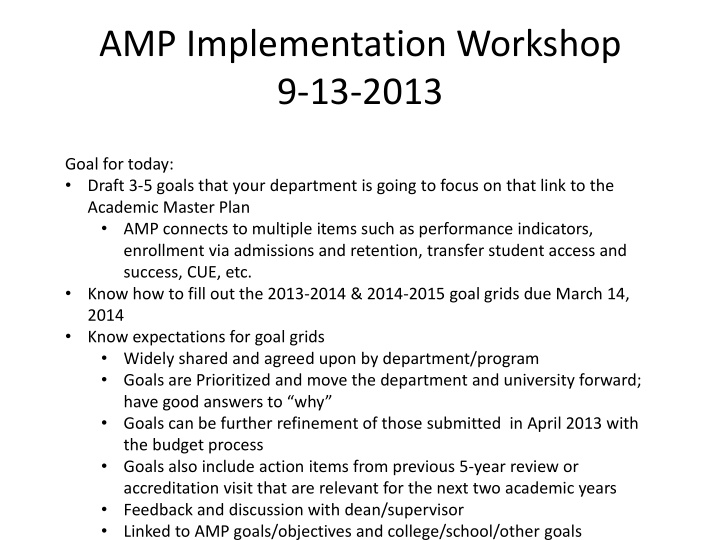



AMP Implementation Workshop 9-13-2013 Goal for today: • Draft 3-5 goals that your department is going to focus on that link to the Academic Master Plan • AMP connects to multiple items such as performance indicators, enrollment via admissions and retention, transfer student access and success, CUE, etc. • Know how to fill out the 2013-2014 & 2014-2015 goal grids due March 14, 2014 • Know expectations for goal grids • Widely shared and agreed upon by department/program • Goals are Prioritized and move the department and university forward; have good answers to “why” • Goals can be further refinement of those submitted in April 2013 with the budget process • Goals also include action items from previous 5-year review or accreditation visit that are relevant for the next two academic years • Feedback and discussion with dean/supervisor • Linked to AMP goals/objectives and college/school/other goals
AMP as an Academic Strategic Planning Tool • Guide the activities of Academic Affairs • Identify and establish commonly-held priorities & goals • Provide stability during challenging budget years & times of leadership change • Integrate with university planning, budget, assessment cycles (annual, 3-5 year, and accreditation cycles) • Priorities and goals drive: – Initiation of new activities – Modification or discontinuation of current activities – Associated resource allocations 2
AMP Approved Approved through Cabinet Level Mission Statement Spring 2012 Goals & Objectives Framing Narrative Vision Statement Strategies Summer 2013 Suggested Activities Implementation Plan Final Version (9/13/13) available at www.ship.edu/provost/amp
Implementing & Integrating AMP Establish culture of ongoing integrated strategic planning at the department level and involving faculty: 1. Standing AMP Committee with ongoing roles & responsibilities – Monitor, assess, report progress on achieving goals, objectives, strategies – Make recommendations for revisions, based on changing environment 2. Annual fall & spring AMP workshops for academic department chairs – Alignment & integration of department/program goals & budget requests with AMP, university strategic plan, PASSHE performance funding factors, and accreditation 3. Links to AMP goals, objectives, strategies required for – Budget, funding, and staffing requests – Recommendations made by various committees and work groups 4
Prioritizing Goals/Objectives: 2013-2015 Overarching Focus Four AMP goals & Why these four? objectives • Prioritized as Critical Need in • 2.1: student recruitment AMP • Overall student success • 2.2: student retention & • Hallmarks of a Ship education persistence • Middle states • 3.1: experiential learning & recommendations high impact practices • Impact on operating budget • 4.1: faculty recruitment & • Linked to PASSHE retention performance funding factors 5
Prioritizing Strategies: Phased-In Approach Strategies Priority Curriculum Students & Faculty & Support & Learning Teaching Administration Critical Need SU should begin to address in D, E, K, N, B, F, G C A, Q the 2012-2014 academic year O, P (next academic year) Essential Need SU should begin to address in H M, L R the 2014-2016 academic years (next 2-3 academic years) Important Need SU should begin to address in I, J the 2016-2018 academic years (next 4-5 academic years)
Recommend
More recommend